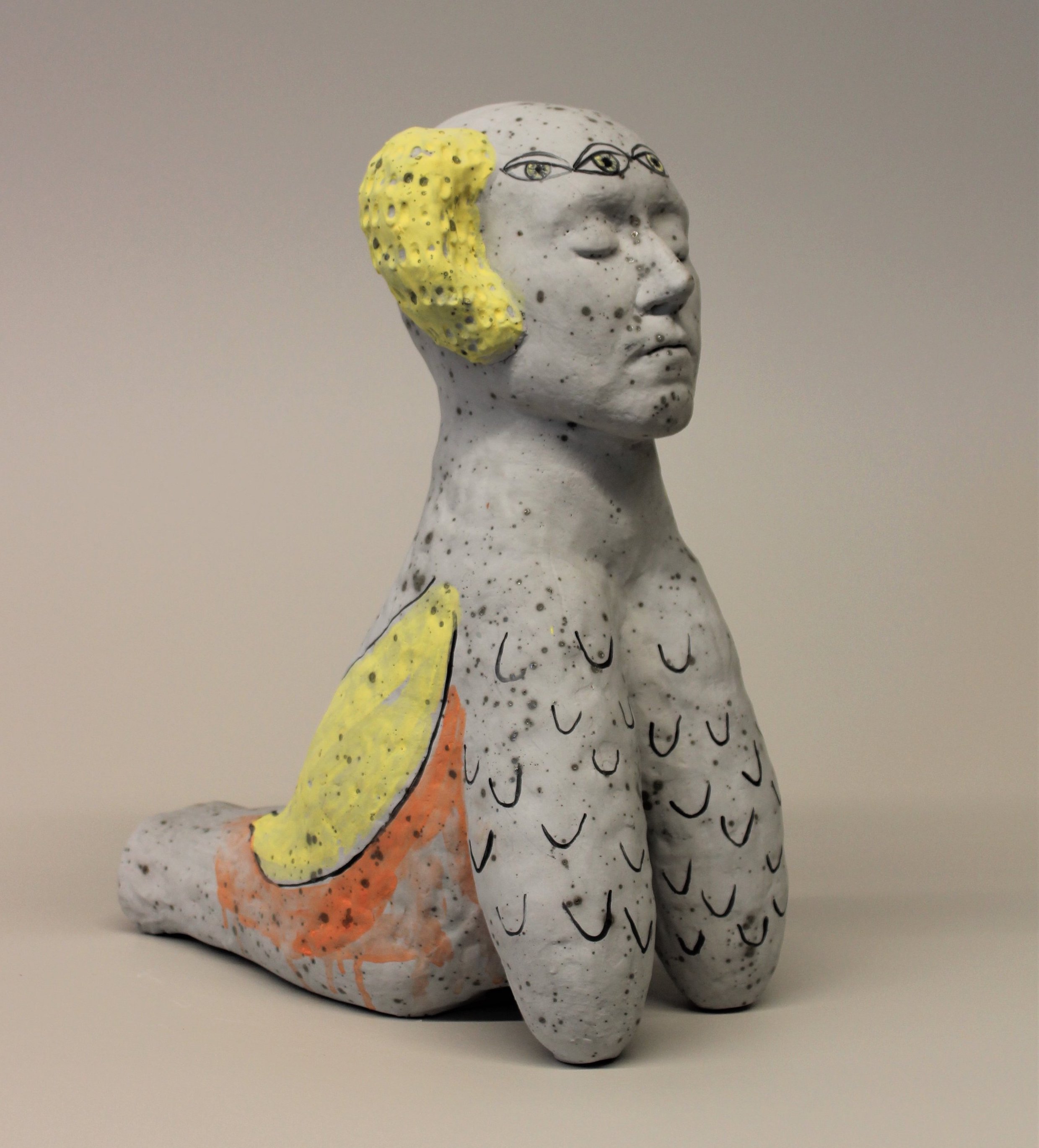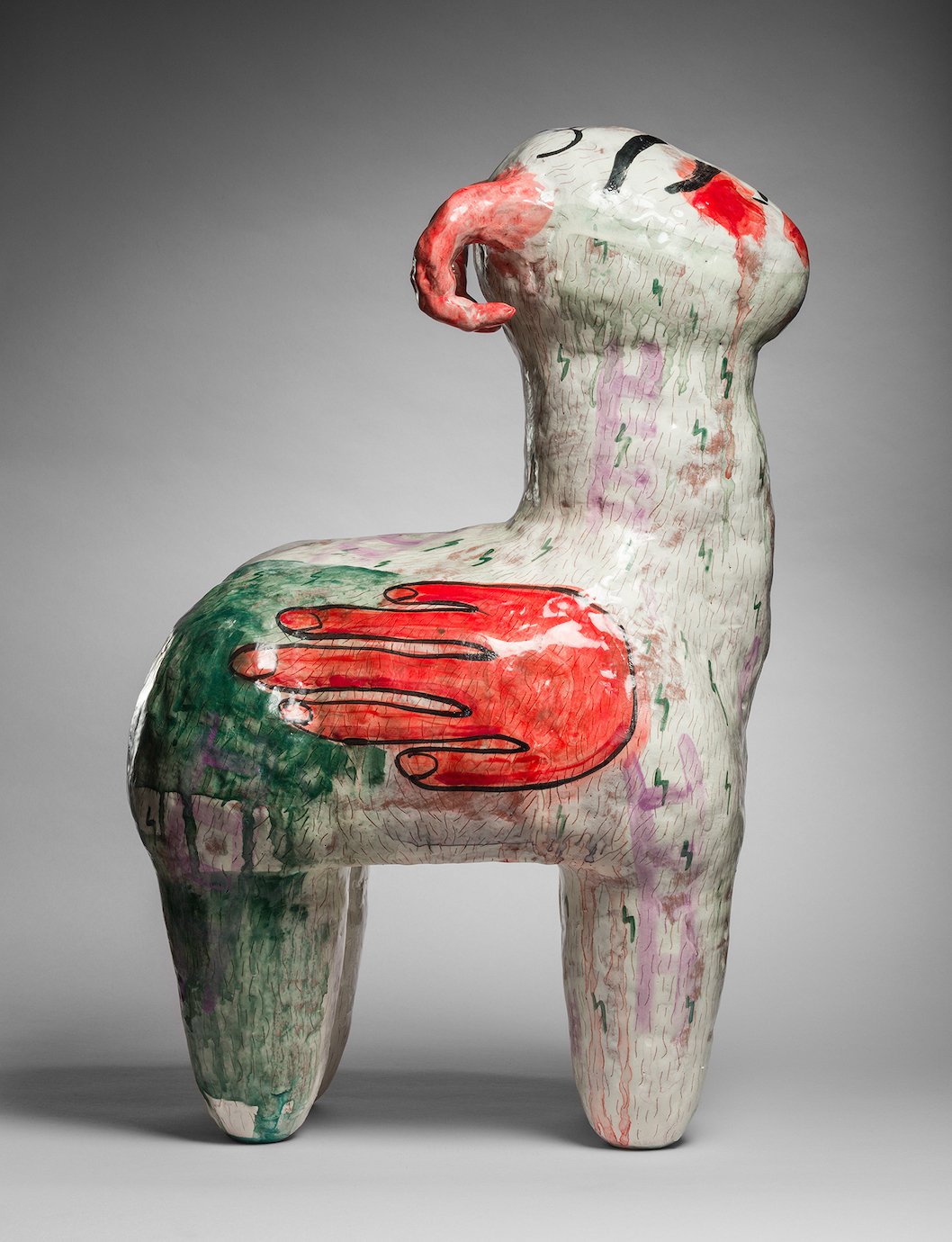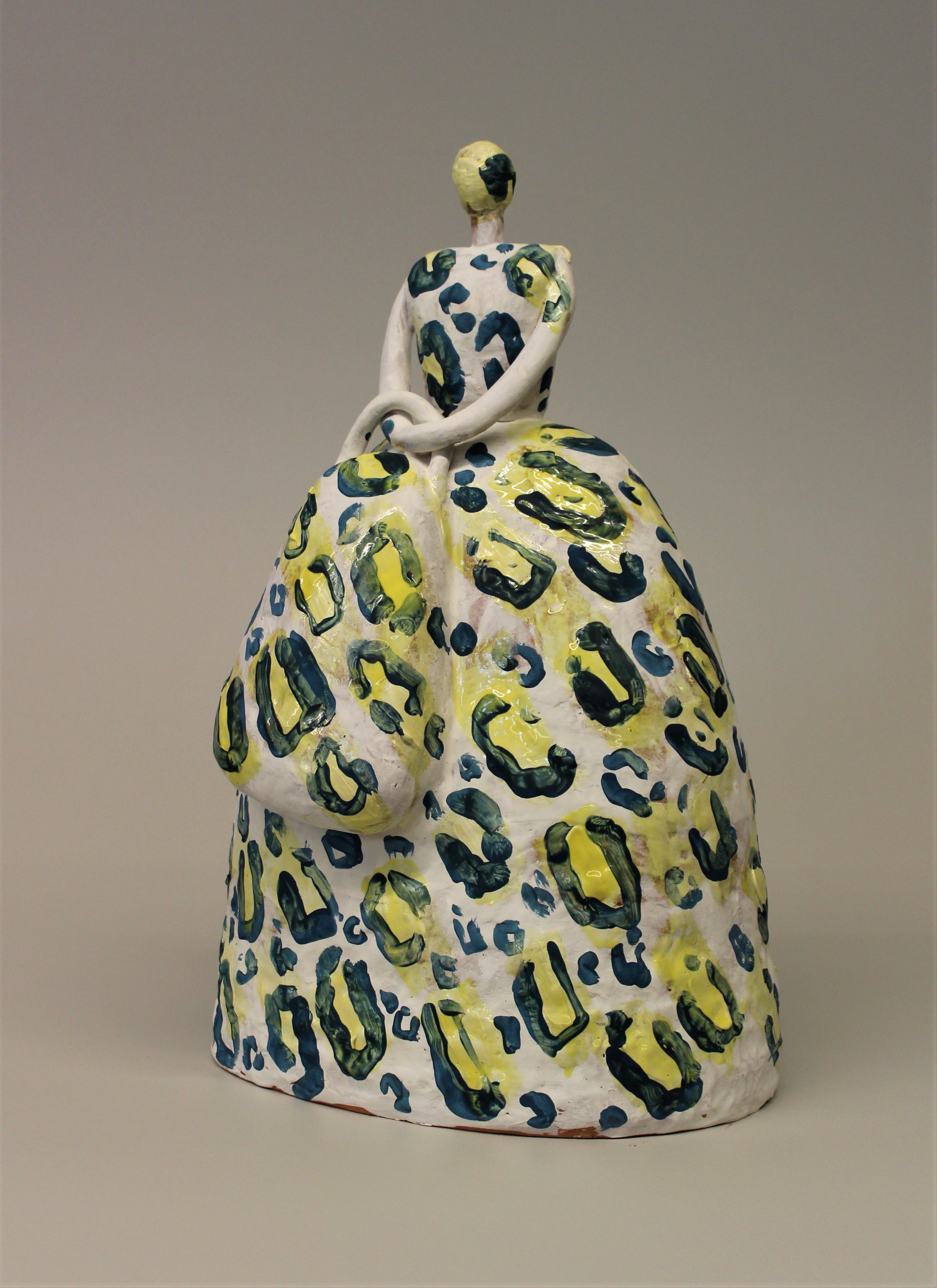Interview with artist Yelena Petroukhina
Yelena Petroukhina came to the US and Arkansas as a senior high school exchange student. After graduating from the University of Arkansas at Pine Bluff with a BA in Art Education, she began teaching while continuing her higher education. In 2022 she earned a Master of Art with emphasis in ceramics from the University of Arkansas at Little Rock. Yelena’s ceramic pieces tell the story of her cultural past and personal journey. More of Yelena’s work can be found at Boswell Mourot Fine Art in Little Rock and at her website yelenapetroukhina.net.





AAS: Yelena, I believe you came to the United States as an exchange student? Is that how you ended up in Arkansas?
YP: Yes, I did! During my senior year in Russia, my parents casually mentioned going abroad for college. To this day, I am not sure if they really meant it when they said it. But I had a travel bug by then and got excited about college abroad. I found two programs; one was an exchange program for 12th grade in the US, and the second was The Malta College of Arts, Science, and Technology. After some research and realistically accessing my English, which was at the foundational level, I decided a year in the American high school would give me some time to improve my English, and make college more accessible.
My host mom happened to be in Pine Bluff. I still can’t believe how lucky I was to meet and spend a year with Dr. Dorothy Wright, one of the wisest, most patient, and most fabulous woman I have met. During my exchange year, I was offered a scholarship to UAPB as an art education major. I was fortunate to study under Henry Linton and Earnest Davidson. I always saw myself as a painter, but after Davidson’s ceramics class, clay became my preferred medium. I spent the entire summer hand-building and throwing on the wheel. I made a VERY large number of pots. Lots of bad ones too, but I started getting good results, experimenting with pit fires, raku, and testing lots of glazes. Currently, I am a visiting artist at UAPB and thankful for the opportunity to give back.
After graduating, I taught for one year, freelanced, and worked for an art restoration decorative painting company, Studio Werks, led by Becky Witsell. During this time, I got to be a part of a fantastic team and worked on restoring several historic sites like the Over-The-Jump Carousel at the Little Rock Zoo and St. Andrew’s Cathedral.
I have been teaching full-time for 11 years and currently work as an art teacher at Horace Mann Magnet. I get to spend my time with some of the most talented young people. I continued my education and received a Master of Teaching at Henderson University and a Master of Art with an emphasis in ceramics from UALR.
AAS: So, was your family was very supportive of your interest in art as a kid?
YP: I always felt encouraged by my family, especially my mother. She grew up in a small town and could not follow her passion. She always talked about her interest in journalism and writing in high school but was unable to follow her heart when deciding on a career. So, she let me try anything that interested me. I can't even remember everything I tried and quit! Piano, tennis, dancing, guitar, Olympic-style wrestling, you name it, I tried it! I was always creative and enjoyed making things as a young kid. Later, I took art lessons in a junior art school program and gained confidence as a young artist. I am thankful that my parents gave me a lot of space and grace to explore, and eventually, art became a constant interest and a career.
AAS: Last year you earned a Master of Art degree from UALR with an emphasis in ceramics. Your thesis show was titled Garden Dwellers? I regret that I was not able to see it. Tell me about putting together that show of your work.
YP: The inspiration for the works in the show came from reflecting on my heritage and the myriad of historical, cultural, and societal factors that influenced the person I turned out to be today. I grew up in a very patriarchal society. Any discussion of women's rights is very limited in Russia, and feminism is nearly a dirty word. I, at this point, have lived in the US for the longest part of my life. My identity and how I perceive the world evolved and became very westernized. Still, I realize that the blueprint I received during my childhood in Russia is still deep within me. I use forms and characters commonly found in Russian folk toys to reference this idea. There are two primary forms typically represented in folk toys: the animalistic form and the form of a woman in a tall bell-shaped skirt. I chose these two forms to convey social and cultural conditioning that women experience, but show them with incredible strength and knowledge of oneself that drives progress, creativity, and innovative thinking in women. The figures wearing tall skirts refer to the societal construct in which women function. The animalistic figures reference the desire for authenticity not framed by history and the pressures of society. Linguistic connections are essential to these works. Just like in other Western cultures, in the Russian language, it is common to make a comparison between women and domestic animals. The language itself insults and takes away humanity. As I think about the various animals and the linguistic nuances of the Russian language, I realize that to call a woman a goat or “koza” in Russian is to point out how difficult and stubborn she is. Essentially, this means she is not budging. I use the images of goats in folk toys to explore ideas of an individual's desires and the sense of authentic self. I embrace this concept and use animalistic figures to express individuality and desires freed from social conditioning. The figures are magnified from the original toy size to make imposing sculptures. I want them to claim the physical space and demand attention. I create these culturally grounded objects to paint my own stories.
I received a lot of support from the faculty while working on the thesis show. I am thankful to Kensuke Yamada, Michal Warrick, and Peter Scheid for giving feedback and challenging my ideas. Joli Livaudais and Lynn Larsen facilitated excellent discussions on contemporary art and how the art I make fits into contemporary art themes.
AAS: Garden Dwellers, is a wonderful piece. Tell me about it.
Garden Dwellers, 20” x 17” x 9”, earthenware
YP: I chose this piece's title as the thesis show's title. Garden Dwellers is a take on the story of Eve. It is a foundational piece to the concept and the body of work as Eve’s story is an origin story in the western world. As I am actively searching for new frameworks and relations to a sense of self within society, I am seeking fresh perspectives on old stories where the female experience is centered and valued. I revisit and rethink stories and representations of women in Western mythology. The story of Eve, described as second-born, first to sin, is the only tale in the Bible where a hero is not allowed to complete a hero's journey. Many Bible characters fall from grace but are allowed to go through the hero's journey, grow, and redeem themselves. All except for Eve. In Garden Dwellers I am rethinking my relationship with the story of Eve and how this origin story propagated in the West affects my ideas of myself. I decorate the animal figure with a snake and a meandering motif representing Eve’s curiosity and the desire for wisdom and knowledge. The garden-inspired painting on the surface refers to the place and possibilities of inner self-growth. In this piece, I contemplate a notion of what if our culture was not based on blame but on taking responsibility for one’s actions and doing the work of self-growth. What if Eve was allowed to complete her hero's journey, grow, and obtain self-knowledge without being punished and stigmatized?
AAS: You also studied at Penland School of Crafts. Was it there where you honed your skills in ceramics and construction of these pieces?
YP: Creating art is mostly a solitary practice. Places like Penland offer a wonderful sense of artist community, time, and place for exchanging ideas and concentrated learning. Before I started my MA at UALR, I longed for that creative environment. Because of my teaching schedule, I save my summers for learning opportunities. I took two summer courses at Penland, both times instructors were outstanding, and I came back creatively refreshed and with a new body of work and a new set of skills. The first course I attended was with Ken Baskin on hard slab construction and soda fire. The second time, I studied under Gaile Kendal and Lauren Karle, both outstanding masters of form and surface. In many ways, skills from these two workshops came together in my latest work. I am working with traditional forms and a personal approach to the surface. I coil all my sculptures; this method allows a lot of flexibility in the size and details I can create. Once the piece is built, I bisque fire it and then glaze it. I use commercial underglazes that I paint and layer to create complexity and depth on the piece's surface. I fire my works multiple times until I am happy with the colors. I use gold luster on some of the details to add the idea of preciousness.
AAS: Another of my favorites is Reflecting on the Possibility of Flight. Tell me about that piece.
Reflecting on the Possibility of Flight, 22” x 13” x 9”, earthenware
YP: In Reflecting on the Possibility of Flight, I place drawings of hands where wings could be on the body of the animalistic figure. I use a cast of my own face to create two faces for the figure, one looking back with painted wide-open eyes and one looking forward with small clouds where the eyes would be. Loosely painted hands on the sides form wings. The piece was inspired by the possibility of moving forward into an unknown future while reflecting on one’s past or upbringing. The symbol of hands being as liberating as wings became a prominent symbol in my visual vocabulary. Working with my hands as an artist and maker is a big part of my sense of self. Images of hands equate to the essential tools I possess. Even though women have been doing manual labor since humankind existed, women are not equated with the physicality of manual labor. I found manual labor affirming, satisfying, and a powerful way to feel and test my spirit and strength throughout my life. The clouds painted on the body of the piece are dreams where I can take on new goals and expand the boundaries I have set for myself.
AAS: You also have a series of ceramics of stylized women in Elizabethan-era dresses. Tell me about that series and The Power and Play in particular. It is a marvelous piece.
The Power and Play, 29” x 16” x 13”, earthenware and gold luster
YP: Power and Play is inspired by the history of how women relate to and experience power. In Russian history, Catherine the Great is one of few female rulers after the feudal period. She is revered as Mother Catherine and portrayed as someone who championed education and enlightenment. In this piece, I form the pedestal skirt in the fashion of the 18th century, as Catherine is frequently seen in the portrait by Vigilius Eriksen. The skirt becomes the pedestal elevating the small female torso over gold rooster heads placed all around the skirt. The rooster is a traditional symbol of masculinity and the traits culturally associated with it. They are finished in a gold luster as valuable objects. To be a woman in power in any but especially a patriarchal country is no small feat of strength and determination. As I reflect on my relationship to power, I understand that history and culture shaped my perception of what power is – who should have it, and how it should be used. In the most recent record, power is seen as power-over. I am redefining my understanding of power from power over to a collaborative and empathetic way to seek wiser solutions to conflicts. Women lead differently, and I believe the perception and ideas of power have been missing women’s input for too long.
AAS: Another from that series I like is Adorned. What is the story behind that figure?
Adorned, 23” x 16” x 16”, earthenware
YP: The figure’s head and face are completely submerged in a cloud of roses. I use flowers, specifically roses, to explore my relationship to cultural ideas of beauty and what is deemed beautiful and valuable. I chose the rose for its long history through time and borders. Roses are heavily cultivated in an attempt to achieve the perfect rose, whatever the standard for this perfection might be. In my work, the rose is synonymous with cultural beauty standards. I made plaster molds of roses to capture the complexities of the flower. Usually, flowers are seen as something we look at and enjoy their beauty. I wanted to contradict that idea by painting large eyes on the skirt of the piece. I want it to look back intensely at the viewer.
AAS: Rider is a fun piece. Was it difficult to construct?
Rider, 16” x 13” x 9”, earthenware
YP: I wanted to merge the two forms I created in this piece. I see both animal form and a woman in a bell-shaped skirt as a part of the same series; both are two sides of the same experience. As I continuously push my work conceptually and technically, merging two forms seemed like a natural direction. To start, I made a small prototype of the idea and created several versions of this form to test how varying proportions affect the structure’s stability and aesthetics.
AAS: You’ve taught at middle school for over 10 years. What do you like most about interacting with kids that age?
YP: I love teaching middle schoolers; they are curious and excited about life; plus, they have a ridiculous sense of humor. The least to say, my days are never dull!
I guide my students through some of their most formative years and help them learn about themselves and the world around them through works of art. As an art teacher, I am lucky to teach in an arts magnet school, and we offer many levels of art classes. I love introducing clay to my students; I always wished I had an opportunity to learn this medium earlier in life. I see many of my students make clay objects and really enjoy the experience’s tactile quality. I think it might be especially needed now since they spend most of the time with screens. This year I am teaching several upper-level courses, and I have many students who are excited about art and exploring it as a serious interest, if not a career path.
AAS: Last year you showed work at Art Basel in Miami. What was that experience like?
YP: Yes, this was very exciting! Kyle Boswell, an owner of Boswell Mourot Fine Art, took my sculpture and Oluwatobi Adewumi drawings to The Scope Art Fair during Miami Art Week. The Art Fair had a very different vibe from, let's say, a gallery opening. Just the number of people attending is mind-boggling. Plus, seeing artwork from around the world and talking to the artists was very inspiring. I met several artists who work with similar themes, and it was interesting to learn about their take on the subject.
AAS: What can we expect next from you, Yelena?
YP: You can most definitely expect more work! The idea I am working with now feels big; I can see working with it for several years. I find myself filling up a sketchbook with ideas and material to create and am consistently making work.
The field of ceramics is evolving at a high pace. There is a lot of outstanding work being created by ceramicists all over the world, stimulating a lot of complex and vital conversations that are taking place. I want to get more involved with regional and national organizations in the ceramics community.






